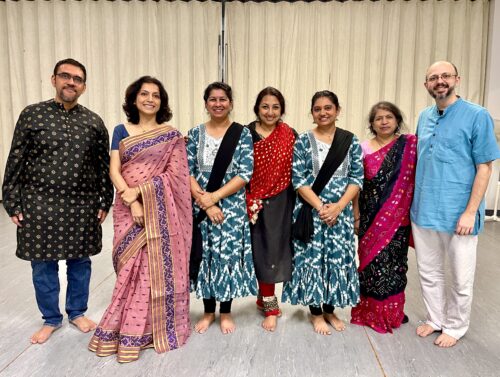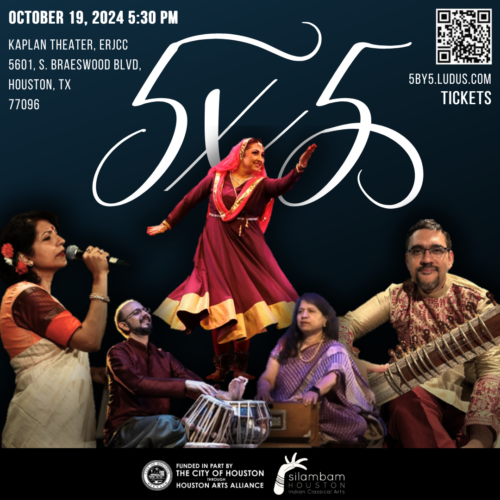Kathak Multiplied: Innovation and Connection in Kalpana Subbarao’s 5×5 Performance
When we consider the purpose of dance and other art practices, we usually discuss their value as expressions of ideas and emotions, contributions to the cultural discourse, creative explorations of a subject, or awareness of a particular point of view. And this is good; if art needs justification, these purposes are more than enough. Sometimes, though, we have or hear of a more mysterious encounter with art. Perhaps it is a sudden and overwhelming emotional reaction, or a sense of connection to something larger than oneself, or a feeling of being a conduit through which the art realizes its own objective. It is more than enough; it is extra. Artists and audiences don’t expect or request this uber experience, and it doesn’t seem to be predictable or contrived. And yet in many contexts, connection with something was the primary purpose of art. We can call this purpose spiritual, or even divine.

I began to reconsider a divine connection to art in conversation with Indian classical dance choreographer Kalpana Subbarao. A software engineer by education, Subbarao’s focus turned to Kathak dance study about a decade ago when she met her guru, Pandit Sontosh Maharaj, while living in Malaysia. Subbarao is also a student of rhythm with Guru Pandit Divyang Vakil. In the Guru-Shishya (master to student) tradition, she considers herself a lifelong student, and she herself is a teacher of Kathak at Silambam Houston. As Subbarao described the sacred origin of dance in Indian cultural history, it was a revelation to me, in whose religious upbringing dance was prohibited. Hearing how one of the major world religions believes in the divine purpose of dance was a fresh and welcome perspective, and since our discussion, I have enjoyed thinking about dance, and all arts, as a conduit to the divine, however, one defines that superhuman, extraordinary concept.
Kathak dance began in the Hindu temples of northern present-day India. As dance and music are artistically entwined, the two forms developed together such that a Kathak dancer is in many ways an instrument, contributing percussive strikes of the foot and rhythmic ringing of bells worn on the ankles. Dancers also contribute vocal rhythms – bol – which precede and signal the musical beats – tabla – to come in the Nritta section of the performance. This is the abstract, technical portion of Kathak, and it can feel a bit hypnotic. In the quest for divine connection, this portion hushes the verbal part of our minds, preparing it for the message that will come in the Nritya, or expressive portion.
In its temple origins, the Nritya dances do more than tell a story. The dancers’ work is to help the audience feel and experience each factual and emotional beat, and they use all elements at their disposal to do so. This includes makeup and facial expressions, jewelry and accessories, the choice of clothing and its handling by the dancer, the positions and movements of the body, of course, and even the state of mind of the dancer. Everything is meant to come together to move the audience along the factual and emotional and even spiritual journey of the dance.

Northern India has always been a fertile, coveted, and well-traveled area. When the Mughal empire took over in the 16th century, Kathak dance moved from the Hindu temples to the Muslim palace courtyards, and its sacred purpose was deflected to a social one. Dancers now told stories of Islamic heritage, making Kathak unique among the traditional Indian dance styles, which otherwise remained Hindu and devotional.
The flexible inclusivity of Kathak is among its merits, and Subbarao is excited to vary the 5×5 program with a combination of dance that is Hindu, Sufi, and Islamic, sacred and folk. The program also features five distinct rhythms in a format that typically showcases two to three, linearly. Subbarao was pushing herself to find connections where multiple rhythms “straddled” each other in the same dance piece. Devotees of Kathak will delight in her discoveries and in this unprecedented program. The 5×5 performance also differs from most Kathak fare in Houston in that it features only three dancers, Subbarao herself and two of her students from Silambam Houston. Most Kathak dance programs seen by Houston audiences feature a stage full of dancers, so this program will have “a solo Kathak feel,” according to Subbarao. In this style of performance, each dancer connects more intimately with the audience while also bearing more of the rhythmic and storytelling weight than would a dancer in an ensemble.
Subbarao and her team do not shrink from formidable tasks. They create – and make time for their art – with a passion that reaches beyond their own satisfaction, a passion that may even propel the audience beyond earthly artistic delights. Shyama Mishra, the 5×5 vocal performer, is a full-time English teacher always looking for chances to advance her art. Harmonium player Dr Jyoti Joshi holds a doctorate in Classical Indian music and is a full-time educator and performer. When not mastering sitar, Dr Rajarshi Bandyopadhyay is a chemical engineer working in renewable energies. Jason Zinn is a front-end web developer who has immersed himself in tabla since 2006. This is an ensemble devoted to Indian classical music and dance, and passionate about sharing it with a Houston audience. It is easy to imagine that what they feel and want to share is that sacred, greater-than-myself experience that was the original purpose of Kathak. I am excited to witness the 5×5 performance and give it a chance to connect me and everyone around me to something brilliantly creative and even divine.
5×5 is presented on October 19, 5:30 PM, at the Kaplan Theater, ERJCC 5601 S Braeswood Blvd, Houston TX 77096. Tickets available here: 5by5.ludus.com
Learn more about Kalpana Subbarao and stay in touch with her work at her website.



Thank you for this wonderful preview and insight into our show! We can’t wait to show it to the audiences of Houston.
Guten Morgen,
wir würden gerne für Sie arbeiten und dafür sorgen, dass erstens Ihre offenen Stellen noch schneller mit den passenden Mitarbeitern besetzt werden, und zweitens Ihre Außenwirkung als starker Arbeitgeber weiter ausgebaut wird – und das kostenfrei!
Denn wir haben uns in den letzten Jahren in unserem Master nicht nur auf Personalgewinnung und wirksames Arbeitgeber-Branding spezialisiert, sondern dies insbesondere für Ihre Branche zugeschnitten.
Das heißt, für Ihre Region kennen wir die Herausforderungen der Personalgewinnung genau und wissen, worauf es ankommt, um passende Kandidaten zu finden.
Jetzt möchten wir mit einer kleinen Auswahl von fünf sorgfältig gewählten Unternehmen eng zusammenwirken, bei denen wir genau wissen, dass wir Ergebnisse liefern
So haben wir für Ihre Region und Ihre Branche:
1. schon eine erste Online-Marketing-Strategie ausgearbeitet, um die passenden Mitarbeiter für Sie zu gewinnen.
2. bislang ungenutzte Potenziale identifiziert, mit denen Sie noch schneller geeignete Bewerber ansprechen und langfristig Ihre Arbeitgebermarke sichtbar stärken werden.
Alles, was wir uns im Gegenzug wünschen, ist die Möglichkeit, Sie als Erfolgsfall nennen zu dürfen, wenn wir in Zukunft mit unserem Angebot auf andere Unternehmen in weiteren Städten zugehen.
Wenn das für Sie fair klingt und Sie vielleicht selbst schon seit längerer Zeit darüber nachdenken, als Arbeitgeber noch sichtbarer und stärker zu werden, dann antworten Sie mir gerne kurz auf diese Nachricht. Wir können dann ein erstes Online-Meeting vereinbaren, um gemeinsam den besten Weg für Ihre Ziele zu finden.
Besten Dank im Voraus und
freundliche Grüße
Leon Haller
Hi! I was wondering if you were looking for someone to help grow your presence on Instagram organically. I developed my own unique system that doesn’t rely on the algorithm. If you’re interested, just shoot me an email at info@leadforest.world